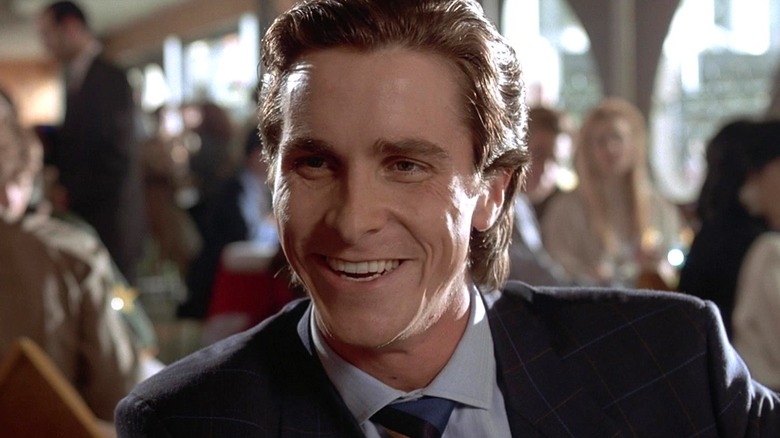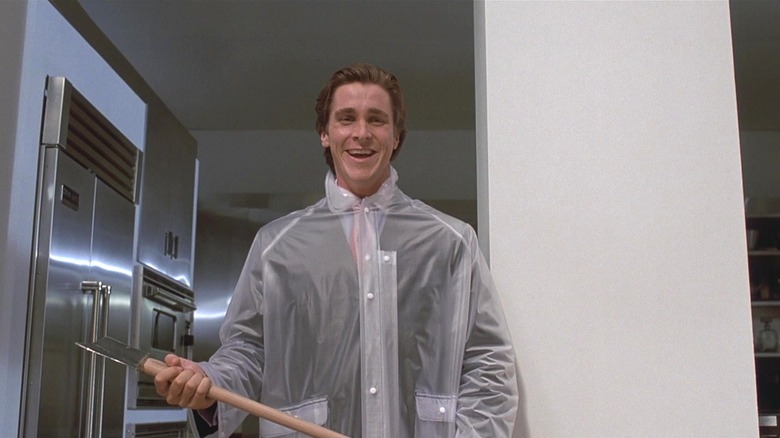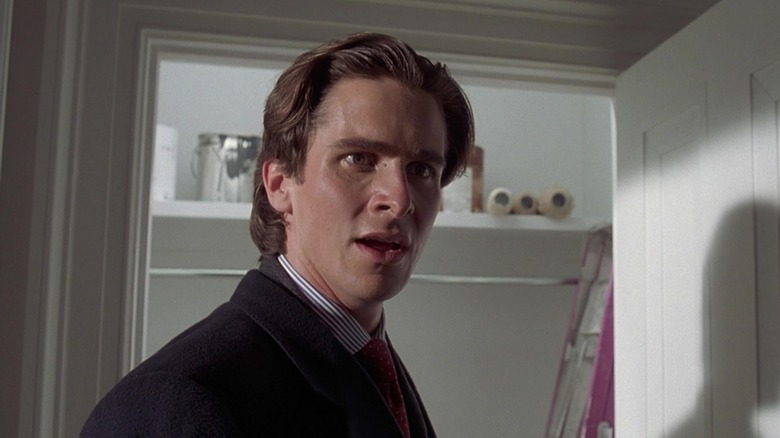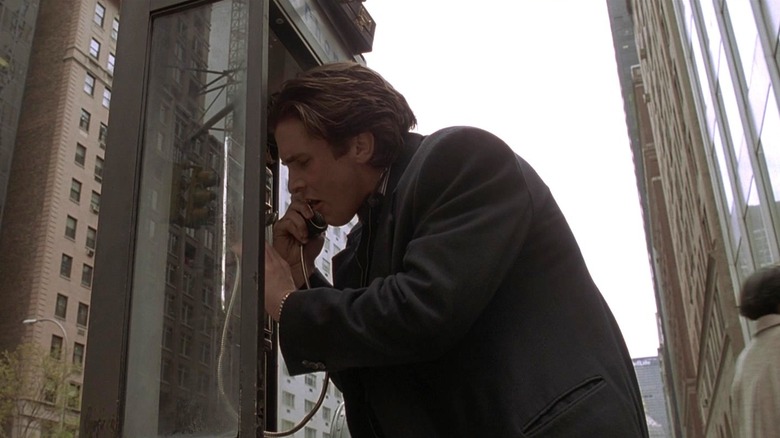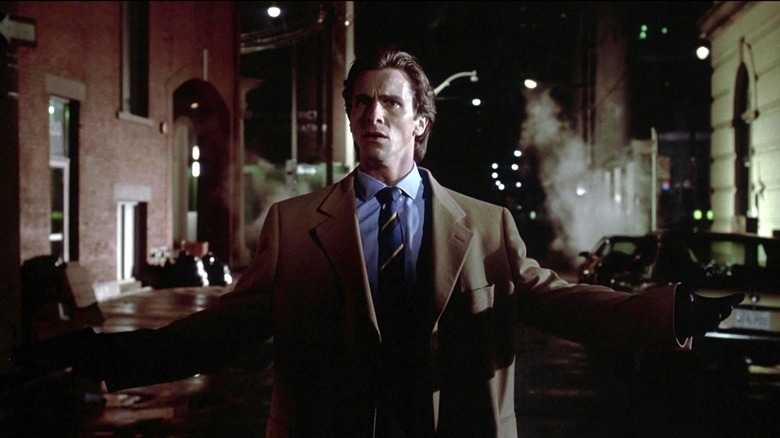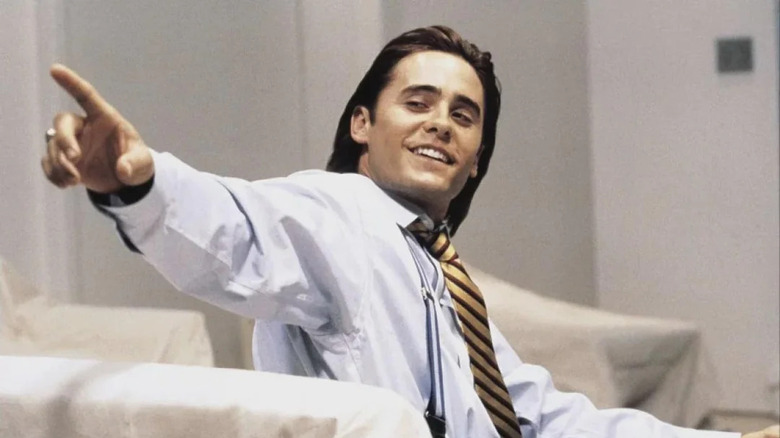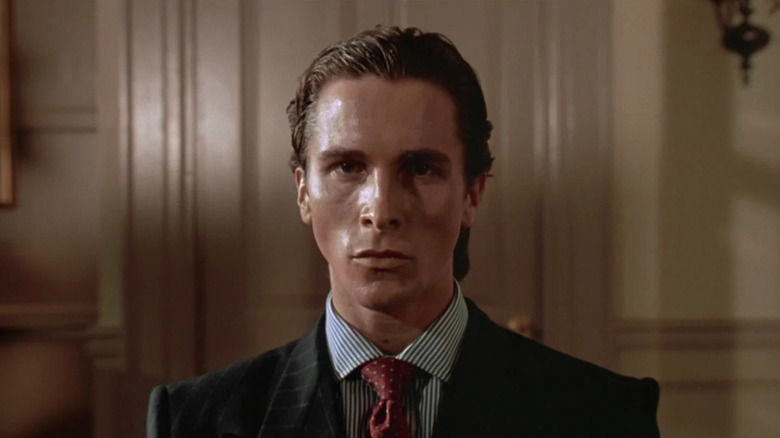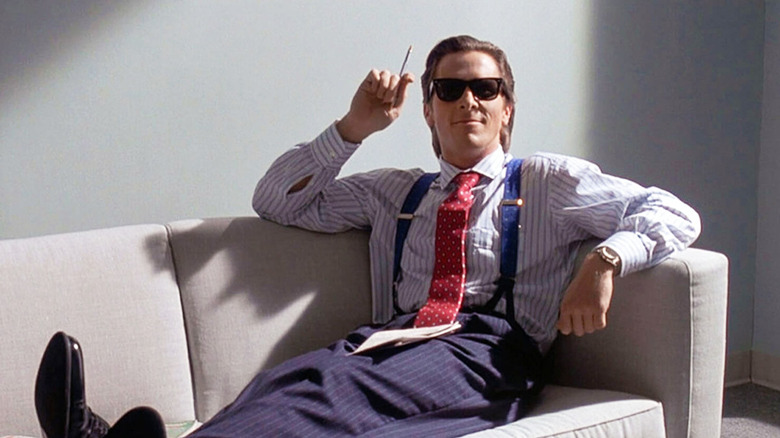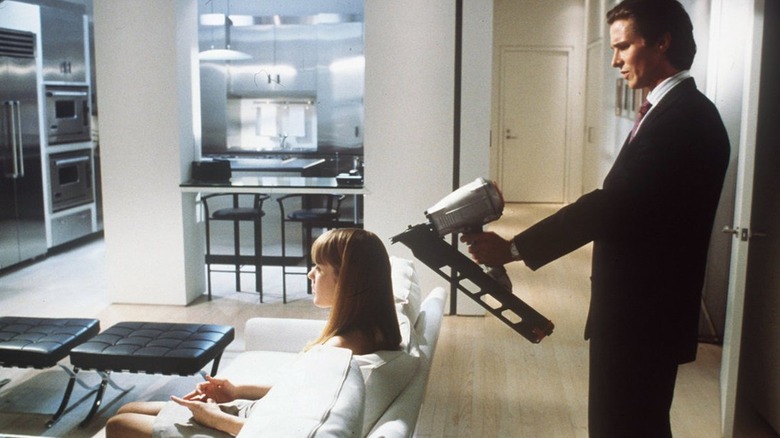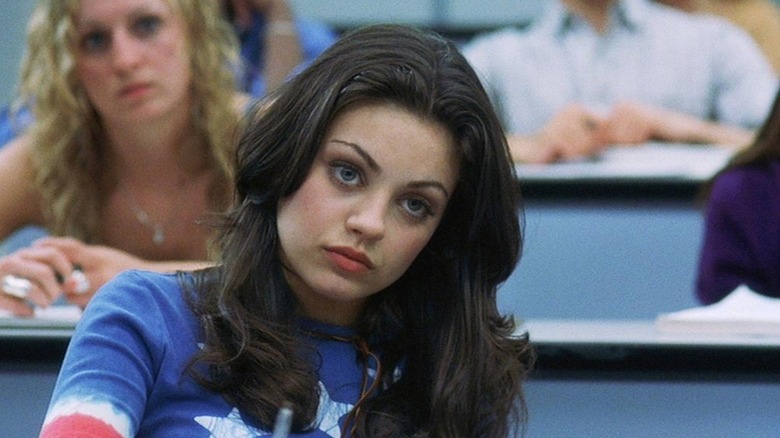American Psycho Explained: Breaking Down The Ending
We may receive a commission on purchases made from links.
"American Psycho," Mary Harron's 2000 adaptation of the infamous Bret Easton Ellis novel, was already mired in controversy before it completed shooting. Ellis' novel was so graphically violent, so loaded with misogyny, that many people thought the movie version would be something close to a snuff film. But Harron and co-writer Guinevere Turner turned in something much different — a darkly funny, only occasionally violent film that took the general essence of Ellis' book and reworked it into something somewhat removed from the novel. Something, some people have even suggested, that was better than the book itself.
All these years later, the "American Psycho" movie has been studied and analyzed, and yet ... there are people who are still not entirely sure about the film's ending. That's by design: The conclusion is ambiguous enough that it can be read in different ways. If you still have questions, I am here to give you some answers — right after I return these videotapes.
Let's meet Patrick Bateman
In "American Psycho," we meet Patrick Bateman (Christian Bale), an investment banker living large in New York City in the 1980s. By day, he's a himbo — a very attractive guy who is also incredibly stupid. By night, he's one of cinema's creepiest serial killers. He murders homeless people, sex workers, and even people he knows (in the book, he also murders a child at the zoo, but that didn't make it into the film). The movie takes us through a few months in Bateman's life as we bear witness to his vapid, bloody existence. The only glimmer of humanity from the character comes in how he reacts to his secretary, Jean (Chloë Sevigny). Jean is clearly in love with Patrick, and while Patrick is incapable of love, he does end up sparing her life after coming very close to ending it (with a nail gun).
One of Bateman's many victims is Paul Allen (Jared Leto), a coworker that Bateman loathes. Bateman murders Allen with an ax in Allen's own apartment and leaves the body there. Later, he brings other victims to the apartment, killing them and hiding their corpses there as well. As the film progresses, Bateman becomes more and more unhinged, to the point where he calls his lawyer and confesses all his crimes. Realizing his blunder, Bateman decides to return to Allen's apartment and clean up the crime scene before it's too late.
What happens at the end of American Psycho
However, a curious thing happens when Bateman decides to cover up his killing spree ... the apartment is not the bloody mess that he left it. Instead, it's been cleaned to perfection — and it's currently on the market. A realtor is there, and she seems either afraid or angry at Bateman (the movie keeps it deliberately unclear; the bottom line is that she does not like Bateman, and she seems to know more than she's letting on). Bateman is confused, wondering what happened to all the dead bodies he left in the apartment.
Not long after this, Bateman runs into the lawyer he confessed to via phone. He tries to explain himself, but as it turns out, the lawyer doesn't even recognize him. This is a running theme in both the movie and the book (more so in the book): No one recognizes anyone. Everyone is so stupid and so coked-up that they're all living in a constant state of obliviousness. In addition to all that, the lawyer thinks the phone call was a prank — and he adds that Paul Allen can't be dead because he just had lunch with him in London. Bateman is understandably confused. Meanwhile, back at Bateman's office, Jean comes upon Bateman's journal, which is full of grisly drawings of his various victims.
Was it all in Patrick Bateman's head?
What are we to make of "American Psycho's" ending? There are commonly two interpretations here, and while I don't think either is "wrong," I personally think one is more accurate than the other. The first interpretation — and the one that I heard the most when the film first came out — is that almost everything that happened in the movie was in Bateman's head. This is an understandable conclusion — even if he's not a murderer, Bateman is clearly mentally unstable, so it's not a stretch to think he imagined everything that happened here.
The fact that Paul Allen's apartment was cleaned up and there was no talk of the dead bodies Bateman supposedly left behind, coupled with the drawings in Bateman's book, tends to make people think the film was one long hallucination. Bateman didn't really kill anyone, this theory states. He simply fantasized about it, and those drawings are his way of bringing those fantasies to life. Another element people use to back up this theory is a scene where Bateman shoots a cop car and the car explodes, leading Bateman to look at his gun, confused. Cars don't really explode when you shoot them — that only happens in the movies, thus Bateman's puzzled look.
If this is how you read the ending of "American Psycho," that's fine! Like I said, I don't think there's really a wrong answer. However, my interpretation is a little different.
Did Bateman really kill people?
The way I see it, Bateman really did kill all those people. Those actions weren't all in his head — they really happened. "But what of Paul Allen's apartment?!" you might ask. There's an explanation for that, and it makes the entire film even more horrific and disturbing. Yes, Bateman really did leave dead bodies in that apartment. However, the apartment is such a prime piece of New York real estate that the owner of the building hushed it up, got rid of the corpses, and is trying to rent it out without anyone knowing.
And the filmmakers back this idea up. Sort of. "To me and Mary [Harron], the book left it up in the air, too, what was real and what was not real," co-writer Guinevere Turner said to MovieMaker. "We didn't think that everything was real because some of it is literally surreal. But we just decided, together, that we both really disliked movies where the big reveal is that it was all in someone's head or it was all a dream."
What really happened to Paul Allen?
One of the most famous scenes in "American Psycho" has Bateman taking colleague Paul Allen (played by Jared Leto) out to dinner, getting him drunk, and then murdering Allen back at his apartment while "Hip To Be Square" plays on the soundtrack. It's a funny, gruesome scene (blood splatters into Bateman's face as he chops Allen to pieces with an axe).
This scene more or less plays out the same in the book, too (although it's worth noting that the character is named Paul Owen in the book), although it's a lot more graphic (at one point, Ellis mentions that chunks of Paul's brains are pushing through the axe wounds in his head). But did any of it actually happen? Again, this all depends on how you interpret the film's ambiguity.
Near the end of the film, Paul's apartment, which Bateman had used for a series of murders, is cleaned up and for sale. On top of that, Bateman's lawyer tells him he had lunch with Paul in London. You can read these scenes in two ways: one is that all the murders were in Bateman's head and Paul is indeed alive somewhere in London. The other is that, like everyone else in Bateman's world, the lawyer character is an idiot who is mistaking someone else for Paul.
What does the director of American Psycho say about the ending?
When Mary Harron was asked directly by MovieMaker if the entire film was in Bateman's head, she replied, "I would never answer that. As Quentin Tarantino says, 'If I tell you that, I take this movie away from you.' I will say there's a moment where it becomes less realistic, and that's the moment when the ATM says, 'Feed Me a Stray Cat.'"
However, when interviewed by Charlie Rose, she elaborated a bit more:
"One thing I think is a failure on my part is people keep coming out of the film thinking that it's all a dream, and I never intended that. All I wanted was to be ambiguous in the way that the book was. I think it's a failure of mine in the final scene because I just got the emphasis wrong. I should have left it more open ended. It makes it look like it was all in his head, and as far as I'm concerned, it's not."
The bottom line — while it's clear some things that happen in the film are in Bateman's head (like the "Feed Me a Stray Cat" scene), the murders actually happened. I personally prefer that interpretation because I feel like making the entire movie a figment of Bateman's imagination lets him off the hook. It says, "It's okay, none of that horrible stuff happened!" And that feels like a cheat to me.
What does the ending of American Psycho mean?
So what does it all mean? While it has a reputation for being a bit of gore-drenched pulp, the "American Psycho" novel, and by extension the film adaptation, is a winking satire of not just the excess of the 1980s, but also of white male privilege. It was recently announced that Luca Guadagnino would be making a new adaptation of the novel — news that immediately resulted in plenty of fan casting. But a lot of that fan casting is missing the forest for the trees: it would be wrong to gender-swap Patrick Bateman, just as it would be wrong to cast an actor of color in the role.
Bateman has to be a white guy because that explains why he's able to get away with everything he does, consequences be damned. Because Bateman is both wealthy and white, he's more or less able to skate through life, protected by privilege. If a woman or a person of color behaved the way Bateman did in the film, they would be shunned and judged harshly. But because Bateman is just another rich white guy, he can pretty much do whatever the hell he wants. Even if Bateman didn't kill anyone, he's clearly deranged — but no one will do a thing about that, because he's protected by his charmed life. He is the living embodiment of white toxic masculinity; if he existed in our present day instead of the 1980s, he probably would be an obscenely wealthy tech bro or a member of the United States government. In other words, he will never, ever pay for his crimes, real or imagined.
As Bateman himself tells us in his closing narration, "[E]ven after admitting this, there is no catharsis; my punishment continues to elude me, and I gain no deeper knowledge of myself. No new knowledge can be extracted from my telling. This confession has meant nothing."
How does the American Psycho movie differ from the book?
Mary Harron and Guinevere Turner's "American Psycho" script streamlines Bret Easton Ellis' novel considerably. Multiple characters are changed or have their parts reduced to make things a bit more simpler and concise. That said, the film does stick pretty closely to the overall shape of the book.
Of course, the biggest difference between book and film is the shocking, graphic violence and sex. Ellis' book is notorious for its brutal descriptions of sexual, sadistic violence that Bateman inflicts on his victims. It's extremely gruesome stuff, and seemingly impossible to recreate on film. While the movie does contain some violent moments, Harron dials things down considerably, to the point where most of the violence is implied rather than witnessed.
Some people consider the film a bit more comedic than the book, and it's true that the film does lean into comedy. But I also think it's worth pointing out that Ellis' book is intentionally very funny. However, his descriptions of violence are so graphic that I think they tend to overwhelm the deliberate comedic moments.
The American Psycho director is shocked by the film's fans
Both Ellis' novel and the film go to great lengths to portray Patrick Bateman as a buffoon. Yes, he's handsome, in great shape, and very wealthy, but he's also a complete idiot. The book makes Bateman's stupidity even more obvious than the film. However, as is often the case with films and TV shows depicting terrible people, some audiences have missed the point. Some people have even embraced Bateman and his various self-care routines as alpha-male behavior worth worshipping.
Needless to say, this interpretation has shocked director Mary Harron. "I'm always so mystified by it," Harron told Letterboxd. "I don't think that Guinevere and I ever expected it to be embraced by Wall Street bros, at all. That was not our intention. So, did we fail? I'm not sure why [it happened], because Christian's very clearly making fun of them."
"Patrick Bateman is like if you took everything terrible about, like, 20th century capitalism and about the Reagan era," Harron said during an anniversary screening of the film (via THR), adding that Bateman represents a "triumph" of "male dominance and money."
Does the sequel change American Psycho's ending?
You might not know this, but there was an "American Psycho" sequel. Released direct-to-video in 2002, "American Psycho 2" starred Mila Kunis as Rachael Newman, a young woman who becomes a serial killer. The film is very loosely connected to "American Psycho," opening with a scene where a young Rachel watches as Patrick Bateman (played by Michael Kremko) kills her babysitter. Rachel then kills Bateman with an ice pick.
To be blunt, the movie is terrible. On top of that, it was never meant to be an "American Psycho" sequel. The script was originally titled "The Girl Who Wouldn't Die," but some quick changes retrofitted it to be an "American Psycho" sequel — a fact that star Mila Kunis wasn't happy with. "I didn't know it would be 'American Psycho II.' It was supposed to be a different project, and it was re-edited," the actress said.
Of course, this opens up a whole new can of worms. If this sequel is canonical, then it officially puts to bed the idea that everything in "American Psycho" happened in Patrick Bateman's head. However, it also implies Patrick Bateman was stabbed to death by a child, so there's that. It's probably best to think of "American Psycho 2" as a story existing completely outside the "American Psycho" continuity ... if you even want to think about it at all.
